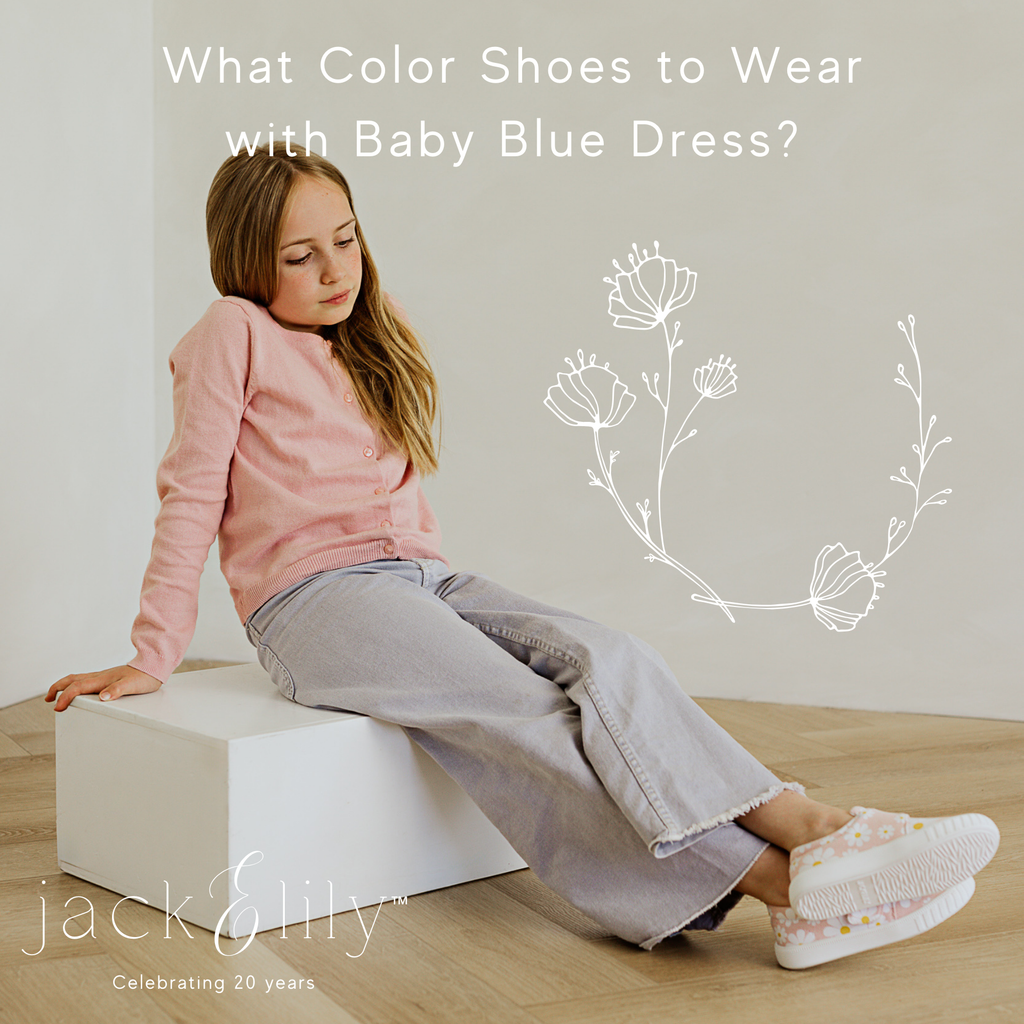Getting your little princess ready for a party, wedding, picnic, or any other special event is bound to inspire your inner fashionista. You will want every detail to be just right. So, if you have bought her an adorable dress in a gentle, pastel shade of blue, you might be wondering what color would be apt in shoes. Opting for shoes that complement or contrast the dress perfectly can help your daughter shine, no matter what the occasion or time of the day. So, what color shoes to wear with baby blue dress? Read on to know about all the options you can pick from and how each hue can make a unique statement.
1. Baby Blue
If you want a cohesive and classy look for your little one, pick up shoes in a light or baby blue shade that exactly matches the dress. Pastels are in vogue anyway, and by keeping the shade consistent for the dress and the shoes, your daughter will be ready for elegant events. To add a hint of sparkle or interest, you can choose a silver, white, or golden hairband.
2. White
White baby shoes like T-straps or slip-ons can complement a soft blue dress flawlessly if you are heading to a beach or summer party. A pristine shade of white is a symbol of purity, innocence, and tranquility, and will help your little girl’s innate beauty to blossom. A hairband with real or faux white flowers can complete the look nicely.
3. Silver
If you are looking to add a hint of shimmer and glamour to your princess’s blue dress, go for silver shoes. This especially works wonders if the dress has a simple or minimalistic design. Choose a mute shade of silver if you prefer an understated look or go for more bling if it’s a big or after-dark event. Match those shoes with trendy silver hair clips.
4. Gold
What color shoes to wear with baby blue dress if you wish your darling to make a luxurious or regal statement? Gold or rose-gold is your best bet. The color is a timeless pick for evening dos and major festivals and goes beautifully with pale blue shades. Tie a simple golden hairband or tiara around your girl’s head for an eye-catching effect.
5. Black
As a color, black will always be a favorite, especially when it comes to shoes. It goes elegantly with all shades and will contrast your baby’s blue dress perfectly. For a stylish statement, choose a shiny pair of boots or T-straps with delicate embellishments like bows, laces, beads, or crystals. And if you are not too sure about going all black, opt for a pair in dark grey or charcoal for a sophisticated look.
6. Beige
Do you want all eyes to focus on the gorgeous baby blue color of the dress? Then picking up shoes in a beige or nude shade can do the trick. A neutral and understated color, beige has the power to enhance the style quotient of any dress manifold. It is also apt for daytime events or casual outings. A pretty buckle, a hint of glitter, or a floral bow can add much charm to an otherwise simple pair of beige baby shoes.
7. Brown
A pair of brown boots can make for an earthy, warm, and chic look when paired with a baby blue dress. Stylish slip-ons and T-straps can also look smart. And there are so many shades you can pick from – cinnamon, mocha, cacao, taupe, tawny, fawn, terracotta, and more. Brown baby shoes are great for formal events and if you match them with your little one’s skin tone, they can visually elongate those adorable legs too.
8. Pastel Pink
It might not be an obvious choice, but pastel pink shoes can lend a very feminine appeal to a baby blue dress. Blush, peachy, and salmon shades of pink are a great idea when it comes to little girls’ shoes. You can balance it with a cute pink headband or one decked with pink roses or carnations.
9. Red
Are you wondering what color shoes to wear with baby blue dress for a bold and energetic look? Consider bright red shades like candy apple, scarlet, coral, ruby, or fire engine. They can lend a whole lot of pizzazz and personality to a simple pastel blue dress and turn heads easily. You can complete your daughter’s ensemble with a bold red bow in her hair or even a cute red purse if she wants to carry one. If it’s cold, put a smart little jacket on her in red to match the shoes and contrast the dress.
10. Yellow
Want to infuse a bit of sunny cheeriness in your princess’s ensemble for a special day out? Consider buying yellow baby shoes, especially boots. Canary, lemon, honey, and bumblebee are some funky and lively shades you can choose from. To complete the look, put a black hairband on your daughter and tuck a fresh yellow chrysanthemum, sunflower, buttercup, or goldenrod in it. Or you can go for headbands with faux flowers too. Orange is another wonderful color to go with if you can’t decide between red and yellow.
Highlight the Beauty of a Baby Blue Dress with the Right Shoes
Now that you know what color shoes to wear with baby blue dress, which option do you want to zero in on? Get your little princess involved too, so she feels happy and confident about the choice. Besides your budget, keep the time of day, type of event, and the style of dress in mind while shopping for the right pair. While simple shoes balance gorgeous dresses, ornamental ones are a better pick for no-fuss dresses. Subtle colors are preferable for day or formal events, while dark or jewel tones are ideal for evening parties. Ensure the shoes are of top-quality, comfy, and supportive as well. No matter how stunning a pair is, it’s of no use unless your child can freely move around in them.
If you are ready to shop now, explore the attractive collection of slip-ons, T-straps, and boots offered by Jack & Lily. Consider getting in touch with the professionals here for more guidance.


